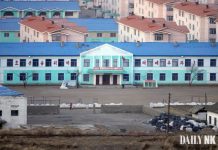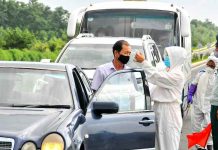There are two key points to make regarding the third North Korean nuclear test.
The first is that, as I have said a number of times in previous columns, North Korea’s nuclear strategy is now in its third stage. The first was to develop nuclear weapons, and the second was their mass production. The third, and last, is to mount a lightweight nuclear warhead on a missile. The successful launch of the ICBM ‘Unha-3’ has secured North Korea the means of delivery, and while they do not know how to achieve atmospheric reentry yet, it is incumbent upon us to prepare for that to happen as well.
Yet, interestingly, many nuclear experts seem to think that North Korea’s overall capability is still at an “elementary” stage. However, the truth is that it is not at all “elementary” where South Korea is concerned.
As ROK Minister of Foreign Affairs Kim Sung Hwan told a National Assembly committee on the 4th, “In 2010 the [uranium enrichment] facility [at Yongbyon] was made public, and if we speculate based on that then it appears they have extracted a certain amount of weapons-grade enriched uranium.”
In the fall of 1996 North Korea signed a secret agreement with Pakistan to import its uranium enrichment technology. This was revealed in the testimony of the late Hwang Jang Yop, and Pakistani nuclear scientist Dr. Kahn also later confirmed it, saying that Pyongyang’s enriched uranium technology is the same as that used by Pakistan. That being the case, we can assume that North Korea has been developing enriched uranium nuclear weapons for almost twelve years. Their reserves of high quality uranium are well regarded in technical circles, and, moreover, because the Kim regime emphasizes military-first politics so heavily, there is no doubt that a vast amount of the nation’s wealth has been put into their development.
Thus, even though North Korea is thought to have acquired functioning uranium enrichment technology not so many years ago, it remains reasonable to presume that they already have a number of these weapons, what the late Hwang described as “enough to use a few and have some left over.” Now why would they do this?
After all, even from the military strategic point of view North Korea has no reason to maintain as many nuclear weapons as the U.S. or the Soviet Union. It would be more than sufficient to have a handful with which to threaten South Korea, Japan and U.S. forces in the western Pacific. After all, anyone who thinks North Korea really plans to attack the U.S. mainland is clearly deluded.
Then why is North Korea producing an ICBM called ‘Unha-3,’ which can reach the west coast of the U.S.? Of course, it is for the purpose of negotiating with Washington. This is the second reason behind the third nuclear test.
An ICBM that can reach the U.S. and a lightweight nuclear warhead are both a clear and present threat to the U.S. Because of this, the U.S. has no choice but to put North Korea on the list of ‘enemies with whom we must negotiate whether we like it or not.’
Without this threat, there would be no other way for Pyongyang to obtain Washington’s attention. A North Korea without nuclear weapons is just a regime burdened by economic woes, inflicting human rights abuses on its people, suffering defections and battling with bottom-up marketization. Only with nuclear weapons are they able to maintain their regime, hidden away from the world. This is how they keep their people in chains: through military tension.
But beyond this, the North Korean regime’s ultimate goal is to “eat” South Korea. The final winner of the inter-Korean game will be he, or she, who gains control of the 75 million people on the Korean Peninsula. Until the game is over, the inter-Korean power struggle is sure to continue. This is the very essence of the past 60 years of inter-Korean relations.
In truth, the only thing that is stopping the North Korean regime “eating” South Korea is the U.S., which is why they want the U.S. to leave and are trying to make that happen via a U.S.-North Korea peace treaty and the abrogation of the ROK-U.S. military alliance. Whether this is realistic or not, it is their only survival strategy.
Therefore, North Korea needs to directly or indirectly negotiate with the U.S. Their statements have recently changed: the National Defense Commission revealed on the 24th that its missile and nuclear tests are aimed at the U.S. No more secrets, they said.
North Korea has thus clearly stated a desire to change the Korean Peninsula frame from one of ‘peninsula denuclearization’ to one of a ‘Chosun Peninsula peace treaty.’ If this were a play, we would indeed say that it is in its third act.
The first act was in the 90s, when the first North Korean nuclear crisis began to play out, through to the meeting in Geneva in 1994. The second act started in October of 2002, when James Kelly visited North Korea, and ended with Siegfried Hecker’s visit in November 2010.
Nobody knows how long the third act will be or what the detailed script is; however, it looks like North Korea’s threats are to become simpler and more aggressive. Then, what can we do?
Simply, South Korea, the U.S. and China must come together and push North Korea into reform and opening. North Korea’s nuclear weapons were created solely to maintain the regime, or, more precisely, to safeguard the supreme leader. 23 million North Korean people are victims of this process. How many North Koreans can we truly say need nuclear weapons? I am sure the majority of the people are much more interested in living well under an open regime.
However, nuclear weapons and the North Korean regime are too closely connected: one cannot live without the other. So forget about it. The important thing here is that the North Korean people want reform and opening. Rather than concentrating on getting rid of the nuclear weapons, if South Korea, the U.S. and China were to focus on reform then 23 million North Koreans would be on their side. The only naysayers would be the one million who benefit from the status quo.
South Korea, the U.S. and China must target this strategy. They must, as I keep mentioning in this column, promote reform, marketization and the free flow of information. If we all focus on this, it will take just a few years to solve the problem. A new era on the Korean Peninsula will doubtless begin.



















